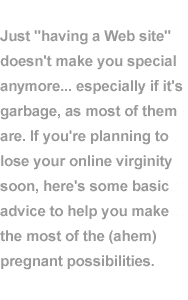 |
|
||||||||||||
 |
|
||||||||||||

|

|
|
By Susan Vaughn
|
By now, you've seen hundreds of them -- business Web sites that hurt the eyes, inflame the sensibilities, and load onto your screen as a glacier moves on a windless day. What, you wonder, did the site owners have in mind? Torture? You swear that when you build a Web site (or finish updating the "cob-Web site" you started a year ago, now rotting away somewhere in cyberspace), you won't make the same mistakes. Or so you hope. According to efuse.com, more than 330 million Web sites now exist in cyberland. This means that competition for your Internet visitors' attention is pretty fiery. Fortune 500 corporations and cash-rich NASDAQ IPOs pour hundreds of thousands of dollars (sometimes more) into their cyberspace addresses to make them into rave destination points. Yet even sites with deep pockets fail miserably. Vincent Flanders, co-author of Web Pages that Suck: Learn Good Design by Looking at Bad Design cites nike.com as a prime example of an expensive but ineffective site: according to him, it's a confusing tangle of unrelated images, invisible hyperlink descriptions, slow-loading graphics, and a strangely quixotic splash screen. The site probably cost Nike far more than you paid for your car, but Nike may not get much mileage from it. Fortunately for the IP who doesn't have Nike's deep pockets, a MacArthur grant, or a well-heeled spouse, forethought and execution are more important than money to the success of a Web site. In the Beginning... The first question to think about is a philosophical one: Why do you want to be on the Web in the first place? To sell? To impress? To educate? To improve customer service? A Web site can do all of the above, but its purpose must be clear to users. They won't be your users for long if they have to work too hard. A Web site should wear its purpose on its sleeve; if visitors can't tell what you're about at a glance, they'll leave and probably never come back. (For an example of a puzzlingly existential site, visit novatel.com.) Closely related to the purpose of your site is the question of its target audience. Are you selling gangsta clothes to 19-year-olds or accounts receivable credit insurance to 65-year-old CEOs? Is it clear who your constituency is? This is important because your rap to the boyz ought to sound different from your pitch to corporate crowned heads. In advertising, this is called "targeted copy." It's an important technique to apply to the construction of a Web site. Once you know what you expect your Web site to do and what sort of people you want to reach with it, you need to think about how to represent yourself, the person behind the site. Since you're in business for yourself, you might want to tell readers what makes you better than your competition. Puh-leaze don't be shy, either. The meek may inherit the earth one day, but they don't get much respect in cyberspace. Establish your credibility. Site visitors will be asking themselves "Why should I hire this guy?" or "Who does this chick think she is?" Dazzle them with your credentials. Let them know how many years you've been in business, what commendations you've earned, which Ivy League degrees your parents paid for, and which well-known corporations fall over themselves to work with you. List the ways you, your products, and your services are superior. Don't be afraid to post your prices; visitors will want to know whether you're affordable or not. To get ideas, visit your competitors' sites -- both those owned by bigger enterprises and smaller ones. What do you like and dislike about them? The Bottom Line If you expect to conceive and build the site yourself, think about how long it will take and how much time you can afford to take away from paying projects. If you plan to contract someone else to build it, be brutally honest about your budget. Prices for professionally created sites vary according to the proposed site's complexity and size. The simplest ones -- "content sites" a few pages long -- might cost between $1,000 and $10,000. For small businesses, $5000 to $7,000 is about average. E-commerce sites (replete with databases, search engines, animated product demonstrations, secured transaction sites, and sophisticated audio/video) start at about $10,000 and can run into the millions if you expect to compete against amazon.com and ccnow.com. If you have more modest aspirations, you might hire ecbuilder.com, which offers e-commerce software. Imagecafe.com sells templates for under $500, and others (efuse.com) offer do-it-yourself programs and guidance. Still others will create a site for you using do-it-by-numbers programs. As long as your site radiates professionalism, it doesn't matter who builds it. Make no mistake, however, says ImageCafe founder and CEO Clarence Wooten, "People are going to judge your business on the quality of your Web site." Day of Reckoning If you decide to create the site yourself, be brutally honest about your artistic and editorial abilities. Your site represents you. It may be the only thing a visiting potential client or colleague sees of your business. If it's chock full of misspellings, unreadable type, strange colors, and exotic English grammar (see tietac.com), you won't do yourself or your business any favors. Kevin Doel of Talon Strategic Communications in Carrollton, Texas, says he first tried to create a site using Microsoft FrontPage. "We were proud of it -- for about a week," he says. "Then we realized that it looked pretty amateurish, and if we were going to be a player in this very marketing-related industry, we'd need to put a much prettier face online." Doel subsequently hired the Risner Naukum Design Group to redo the site and says he's very pleased with the results. Publicist Sally Hodge of Hodge Communications (hodgecommunications.com) paid $7,000 for her site. It was "a big bite," she concedes, but feels the expense was worth it. "I'm getting two to three new business queries weekly off this site," she says. "Of those, I've gotten two solid new clients whose fees will more than offset any enhancements I might make to the site." If you're hell-bent on hiring a designer, but lack the bucks deluxe, consider a barter arrangement. Such work-for-design swaps are becoming increasingly popular these days. Bells and Whistles Get your visitors' attention. In cyberspace, first impressions are everything. Web visitors typically keep their hands on the mouse, ready to click away the second they lose interest. Therefore, think carefully about the first images visitors will see. Will users really be as excited as you are about that giant checkered Italian Cursive logo? Doubt it. Choose something startling, witty, newsworthy, or imaginative that represents you and your work. That said, keep it simple too. Which brings us to...
|
||||
| |||||
|
October 8, 1999 Primay Editor: Eric Gershon Illustration by Steve Smallwood Production by Keith Gendel |
We'd love to hear your comments about this article! Susan Vaughn is a freelance writer who lives in Los Angeles, CA. If you like, we'd be happy to put you in touch with her, or with any of the other IPs named in this article. | ||||
| |||||